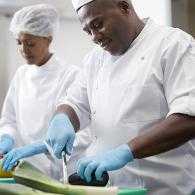The ABC On Food Safety
Although most common foodborne diseases like Salmonella, Campylobacter, Listeria and Escherichia coli are very well known, intensely examined and surveyed over dozens of years. Nevertheless these pathogens still affect millions of people annually over the world.
An estimated 500 million – almost 1 out of 10 people in the world – fall ill after eating contaminated food resulting in 230 000 deaths every year. Children under 5 years of age carry 40% of the foodborne disease burden, with 125 000 deaths every year.
Foodborne illnesses are usually infectious or toxic in nature and caused by bacteria, viruses, parasites or chemical substances entering the body through contaminated food or water. This particularly affects infants, young children, elderly and the sick.
The Predominant Antagonists
Data from around the world show some common elements. Salmonella is still the most important agent causing acute foodborne disease.
Foods of animal origin, particularly, meat and eggs, were most often implicated. Desserts, ice cream and confectionery items were also involved, but some of these would have egg as a raw or incompletely cooked ingredient.
Incidents most frequently occurred in homes or restaurants, and the main factors contributing to outbreaks were poor temperature control in preparing, cooking and storing food.
Clostridium botulinum, Salmonella and E.Coli are more frequently documented in industrialized than in developing countries. Strains of E.Coli, Shigella, Vibrio cholerae and parasites are the main scourges in developing countries.
The Rise And Fall Of Foodborne Illnesses
We’ve come a long way to tackle food safety over the last decades when for example in the early 19th -century “whisky” was actually a watered down ethyl alcohol tinted brown with prune juice and “coffee’ featured ingredients like sand, tree bark, ground acorns and charcoal.
Without stating the obvious, today food safety laws, labeling requirements and food supplements regulations can be found in most administrations around the world. Governments are increasingly making food safety a public health priority, as they play a pivotal role in developing policies and regulatory frameworks, establishing and implementing effective food safety systems that ensure that food producers and suppliers along the whole food chain operate responsibly and supply safe food to consumers.
But We Are Definitely Not There Yet
Despite intensified prevention efforts, foodborne illness remains a persistent problem. Recent large foodborne outbreaks have led to claims that the number of foodborne disease outbreaks and concomitant illnesses has increased in recent years.
There are a number of reasons for this. First of all the production of food is an increasing large-scale process and the worldwide distribution of food and globalization of the food supply are factors that can enlarge and aggravate a potential (local) infection.
Furthermore food safety-related trends like eating outside of the home, the emergence of new pathogens, and growing population of at-risk consumers also definitely play a role. And last but not least, the burden of foodborne diseases to public health and welfare and to economy has been largely underestimated over the last decades due to underreporting and the difficulty to establish causal relationships between food contamination and resulting illness or death.
As the world’s population is growing, the intensification and industrialization of agriculture and animal production to meet increasing demand for food creates both opportunities and challenges for food safety. Climate change is also predicted to impact food safety, where temperature changes modify food safety risks associated with food production, storage and distribution.
Call For Action
These challenges put greater responsibility on authorities, food producers and handlers to ensure food safety. In every step in the chain, food safety needs to be covered in all its facets.
The authorities must demonstrate leadership and assist in the development and strengthening of risk-based, integrated national systems for food safety and enable a science base for measures along the entire food-chain. The international and national cross-sectorial collaboration needs to improve and enhance communication and advocacy. In addition, more effective food safety education programs for food operators, food handlers and consumers are to be developed .
The Diversey Food Safety Connection
Of course the business field operators play a significant role in the whole food safety performance. And cornerstone companies like Diversey can reinforce and lend a hand towards safer food as hygiene and food safety are undoubtedly a vital part of the DNA of the company.
Within our dedicated pillar Diversey Consulting we have a broad expertise in food safety and can provide smart solutions from building a robust food safety infrastructure, through training, to monitoring the effectiveness of a food safety program.
Diversey Consulting will work with a food operator to untangle the requirements and create an actionable audit and training plan, or sample food, water and surfaces and analyze the parameters together with accredited, independent labs.
This devoted club of experts can even provide a digital food safety platform, incorporating constant remote monitoring and an accurate overview of the entire food safety program at one’s fingertips.
And with their significant presence across the world, they can deploy global programs or local applications as needed. So lean on Diversey Consulting to shed light on your food safety requirements.






